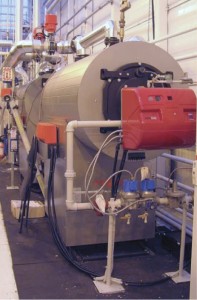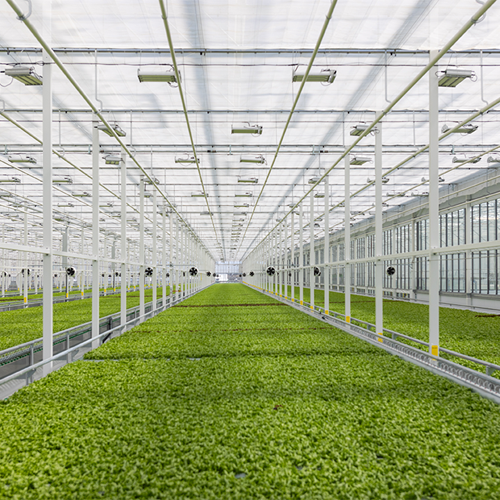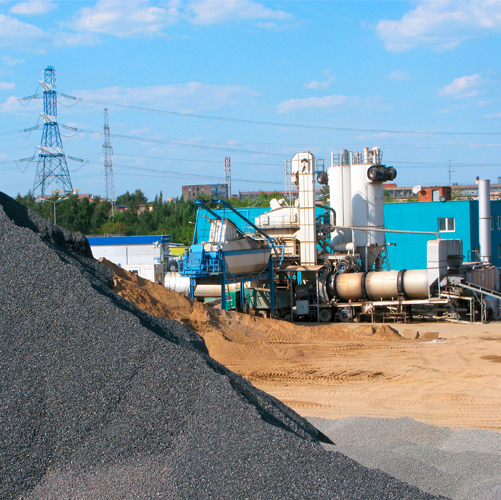Lufa Farms: an innovative entrepreneurial concept
Lufa Farms’ reputation was built on innovation. The concept: It farms fresh produce in rooftop greenhouses covered with tempered glass on commercial urban buildings in Quebec. The plants are grown on slabs, without the use of synthetic pesticides, herbicides or fungicides. On harvest days, produce is picked in the morning, packaged and then delivered in the afternoon to different community drop-off points around the city. The proximity of its customers allows Lufa Farms to reduce transportation and handling costs.
And now, to remain competitive, Lufa Farms uses highly efficient technologies to grow its fruits and vegetables.

Heating system, process and ventilation: innovative efficiency
HEATING
To maintain a stable, suitable temperature in the greenhouse, Lufa Farms uses the following technologies: horizontal and vertical thermal curtains, insulation around the greenhouse perimeter and a buffer-wall of insulated air. The greenhouse is also entirely automated in order to optimize energy efficiency, particularly with respect to CO2 management.
The boiler room operates with top-performing natural-gas heating equipment that uses high-efficiency (over 95%) thermal condensation.
The greenhouse’s innovative heat-distribution system uses in-floor heating rails in rows between the plants, combined with polyethylene tubes underneath the plants.

CO2 INJECTION
The CO2 is injected into the air-buffer zone, drawn in by ventilators and redirected to the plant bases through the polyethylene tubes.
VENTILATION
A greenhouse’s temperature and humidity are regulated by its ventilation system. It is made up of a complex process involving heat exchange with outside air as well as proper regulation of the greenhouse’s heat, CO2 production and humidity level.
The conventional method for cooling and controlling humidity in a greenhouse is through ventilation and heating. Through this process, a percentage of the hot, humid air inside is replaced by cold, dry air from the outside by means of a retractable roof. Greenhouses normally have roof ventilation (natural) or side-ventilation (mechanical). This method will minimize CO² injections. Production in semi-closed greenhouses aims to maintain optimal humidity and temperature levels to limit outside heat and air transfers and to conserve a higher CO² level to stimulate photosynthesis.
To optimize operating costs, Lufa greenhouses only use roof ventilation when absolutely necessary: either to evacuate heat or release excessive pressure in the greenhouse. Most of the time, however, the air-buffer zone takes care of ventilation. When cooling becomes necessary, flaps open to let in outside air, which passes through a ventilation/buffer wall (i.e. water circulates to cool down the outside air). When necessary, the air is heated with a water-to-air heat exchanger. These systems reduce energy consumption, as well as the volume of air treated.
To ensure that concrete energy savings are achieved, the following parameters were observed and measured on a regular basis:
- outside temperature data from the greenhouse’s weather station [JB1] (°C);
- inside greenhouse temperature data (°C);
- data on the sunlight absorbed by the greenhouse (W/m²);
- data on the relative humidity inside the greenhouse (RH %);
- data on the relative humidity outside the greenhouse (RH %);
- data on wind speed and direction (cardinal points and m/s or km/h);
- heating unit operation periods (state).
Concrete results
Lufa Farms has implemented an innovative and highly efficient system that will reduce costs.
By combining high energy efficiency boilers with insulation measures (thermal walls and curtains) and automation, Lufa Farms achieves 50% savings, compared with an equivalent traditional greenhouse.
Another interesting fact is that a semi-closed greenhouse has a smaller open or working outside surface-area than a standard greenhouse. As a result, a much smaller quantity of air has to be treated, bolstering energy savings.
Since crops are fast-growing live organisms, they require continuous, daily monitoring to maximize harvests and ensure continual energy savings.
By Richard Meunier, eng., CEM
Advisor, Technologies and Energy Efficiency DATECH Group, Gaz Métro
Collaboration: Marise Vallières, Eng., CMVP
Environnement-MJ inc.
![]()
Continue reading








